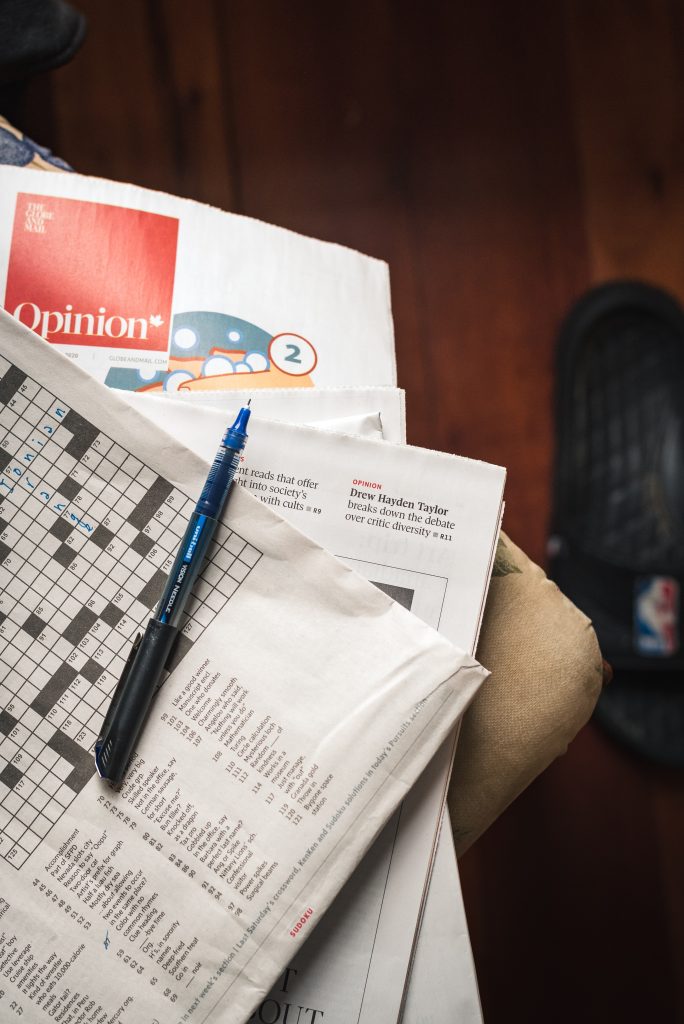I’ve been a word nerd for as long as I can remember. And I’ve been a cruciverbalist—a crossword fan—since at least junior high. That’s when my big sister started buying me Dell magazines, which had crosswords of varying difficulty plus many other kinds of puzzles:
- logic puzzles (You solve a problem by deciphering a series of clues and figuring out which ones fit together.)
- cryptograms (You crack the code for a piece of text by exchanging each letter for the letter of the alphabet it stands for.)
- acrostics (These combine cryptograms and crosswords. You solve clues and transfer your answers to a numbered grid that spells out a hidden quotation.)
- diagramless crosswords (You have to build your own grid as you solve the clues.)
I remember a time when I thought crosswords were very hard if they didn’t indicate two-word solutions. I don’t need prompts like that anymore. In fact, the harder the crossword, the better I like it.
For me, the perfect weekend morning is staying in bed until I’ve finished both the Saturday and Sunday New York Times crosswords. Once in a while, I even finish both without having to peek at the answers. Bonus!
Saturday’s crossword is always good and hard; some weeks I don’t know a single answer on my first run-through. Sunday’s is fun because it’s built around a theme or clever quirk (like requiring two letters per square in the answers).
I don’t bother with the weekday crosswords anymore unless I’m really bored (or really procrastinating about getting to work): they aren’t much of a challenge anymore. I also like the cryptic crosswords in the Globe and Mail, now that I’ve figured out how to do them.
I got to wondering, the other day, who invented crosswords? And when?
So I looked it up. (Three cheers for the internet!)
Word-square puzzles and acrostics date to ancient times, but the modern crossword is a fairly recent invention. It was created by Liverpool-born journalist Arthur Wynne, who prepared a diamond-shaped “word-cross” puzzle for the Sunday “Fun” supplement of New York World. The puzzle appeared in print on December 21, 1913. A few weeks later, an illustrator reversed the words in the title, turning “word-cross” to “cross-word.” And a typo later turned “cross-word” to “crossword,” the name we use today.
Arthur Wynne’s invention launched a crossword craze. Soon every major newspaper in the United States included a regular crossword. Except for the New York Times. NY Times editorials throughout the 1920s and 1930s condemned crosswords as “a primitive sort of mental exercise” that was a sinful waste of time.
It took a war—and the bombing of Pearl Harbor—for things to change.
In February 15, 1942—two months after the attack—the Times published its first crossword as a diversion to help readers cope in a nation at war.
Crosswords were a welcome escape, and have remained a popular pastime. They’re even gaining popularity.
A recent article in Smithsonian Magazine notes that more people are solving crosswords than ever before, and that crosswords are increasingly popular with young people.
Perhaps this is because crosswords are quick to mirror how people talk and write. It’s true that words like sext, tweet, LOL and meme appeared in crossword puzzles long before they appeared in dictionaries.
But what’s the real reason crosswords are popular? I think it’s because they’re fun!

Interesting. I personally hate to go cross eyed over crosswords even though I know they’re good for my brain.